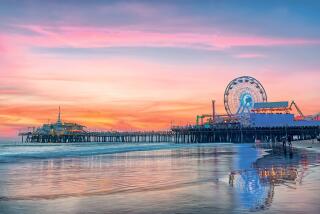PERSPECTIVE ON CRIME IN L.A. : Face It: Every One of Us Is at Risk : David Falconer’s murder strips the illusion from statistics; the whole city is becoming one level, bloody playing field.
The hold-up murder of choirmaster David John Falconer last week outside a Los Feliz convenience store brings Los Angeles to a new level of consciousness in the current crisis of violent crime in this beleaguered city. Just as the Northridge earthquake affected everyone equally, regardless of color, occupation, income or address, these days, every one of us in Los Angeles is equally liable to being cut down by murderous strangers.
I know the riposte: Why, you ask, should the murder of one white man--a choirmaster with a doctorate in music from USC, a beloved teacher, a gentle, caring soul--be considered any worse than the gunning down each weekend of a dozen less-privileged Angelenos, the majority of them people of color?
Precisely! The murder of anyone, the brutal termination of a human life, is equally heinous. But have we not, in considering the statistics of who is murdered, and where, concealed the universal implications of this crime wave? We say: Most people killed in Los Angeles are people of color. In saying this, we delude ourselves that random murder is an ethnic affair.
In and behind such grasping at statistical illusions is an implied argument, perhaps even a desperate hope. If murder is a matter of ethnic identity, then in Los Angeles, the most de facto segregated city in the nation, being at risk is a matter of residence and choice: Avoid certain neighborhoods, certain kinds of people, and you significantly decrease your chances of being a murder victim.
The statistical comfort of living in one part of the city or another, or of merely being in one part of the city or another, has now, in the slaying of David Falconer, forced an acknowledgment of a reality about which Angelenos prefer not to talk: our universal vulnerability. Soon, very soon, it will not matter who you are, or what your color is, or where you live. The very fact that you are in Los Angeles will overwhelm all other statistical odds as the playing field, the killing ground, becomes increasingly level. Gangbanger or choirmaster, you will be equal before the terror.
It was debilitating for us to see crime as something happening in someone else’s neighborhood. Now we face an equally debilitating notion in our impending acknowledgment of universal vulnerability. If crime in Los Angeles is one vast Lotto game with everyone given an equally empowered number, then we will begin to play the odds against each other. We will look across the table at dinner parties, we will look to the next desk at our office, we will glance out of the corner of our eye at the person sitting next to us in the movie theater, and we will ask: Who’s next? You? Me? The guy across the room? Each Angeleno will regard the other’s vulnerability as a way of lowering one’s own statistical probabilities for being a murder victim. This will result in a social and psychological solipsism--a defensive self-centeredness based on the most fundamental motivation of all, fear in the face of a threat to survival--that will do great damage to the moral and civic fabric of Los Angeles.
Even with this new insight, Angelenos might be tempted to comfort themselves with another statistical delusion. The odds, they will argue, still rest mostly on ethnic identity and place. True, as far as statistics go.
But apart from the enclaves of the very rich, Los Angeles is a patchwork of neighborhoods where the borders between “safe” and “dangerous” are increasingly blurred, where old-timers and strangers pass one another on every street, in every convenience store.
David Falconer lived in Silver Lake and was killed in Los Feliz. Los Feliz is one of the most civic-minded, preservationist-oriented districts in the city. Silver Lake, despite marginal aspects, is attractive enough to be the home of former City Councilman Mike Woo. Shall these neighborhoods now be ranked alongside South-Central in the category of danger? The answer, unfortunately, is yes. In an era of universal vulnerability, with highly mobile robber-killers plying their trade wherever they choose, no neighborhood is safe.
Nor is being middle-class any longer an adequate shield. Statistics tell us that death by violence is a matter of poverty--another statistical illusion of safety. But Falconer was solidly middle-class, doing a middle-class thing: buying a snack on his way home from a productively middle-class day teaching music.
What does it do to a city when being middle-class offers no protection? (We already know what it means to a city when being poor implies a high certainty of violent death.) And is not evidence gathering that the upper-middle classes are sharing the vulnerability of their middle-class brethren? Only the wealthy, surrounded by private security, can, temporarily, escape the odds. And how long will that last?
The children of St. James Episcopal School on Wilshire where Falconer taught are devastated. One 10-year-old told her mother that she cried until the tears no longer came. She was weeping for all of us. Better to weep as a prelude to action than to succumb to this crime epidemic. Better to weep, and perhaps even to grow angry, than to play the odds against each other.
More to Read
Sign up for Essential California
The most important California stories and recommendations in your inbox every morning.
You may occasionally receive promotional content from the Los Angeles Times.










